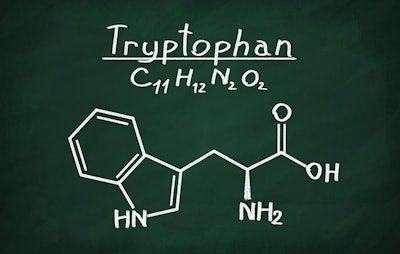
Tryptophan is an essential amino acid for all animals. It must be provided in the feed of monogastric animals in the form of intact proteins (such as those in soybeans or rapeseed) or as feed-grade L-tryptophan — an amino acid that is manufactured for the animal industry.
As it happens, tryptophan is practically always limiting in most commercial diets for pigs and poultry, meaning their feeds based on cereals and vegetable proteins do not contain enough natural (from wholesome ingredients) of this amino acid. The problem becomes worse when we consider modern diets are formulated based on the principle of low-protein, which implies natural protein sources are substituted by feed-grade amino acids to reduce wasted amino acids above animal needs. A rather complicated matter, but the focus here is tryptophan that is needed in most diets. And the real problem is that its cost is often 10 times as high (or even higher) than the rest of available commercial feed-grade amino acids. Thus, many nutrition professionals prefer to use limited amounts or none at all.
The real problem is that its cost is often 10 times as high (or even higher) than the rest of available commercial feed-grade amino acids.
The role of tryptophan lies beyond protein synthesis to include biological functions such as appetite regulation and control of sleep via its metabolite serotonin. Modern research indicates that tryptophan may be implicated even in immune defense systems. Here there is an increasing amount of literature that debates these issues at great depths.
When it comes down to practical feed formulation, a nutrition professional — someone who actually formulates diets — must decide what ratio of lysine to tryptophan should be used. The majority of such professionals would agree on a level of 18 percent (that is if lysine in the diet is 1 percent, then tryptophan should be 0.18 percent). There are voices that claim 15 percent is good enough — perhaps in high health animals, whereas others claim that 24 percent is the required level to have all non-nutritional benefits included. The latter, of course, brings a substantial cost burden to the feed designed. In the end, it is left at the discretion of the nutritionist to decide which tryptophan ratio to select based on expected outcome.















